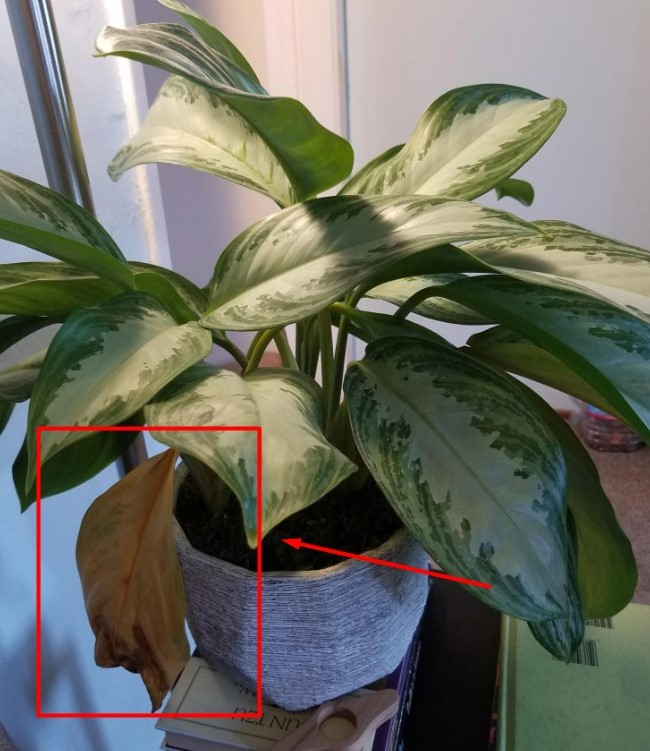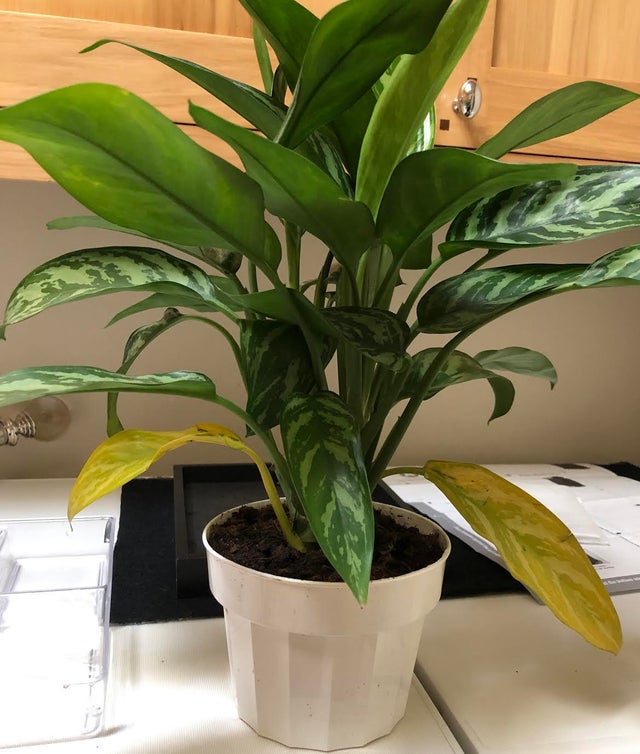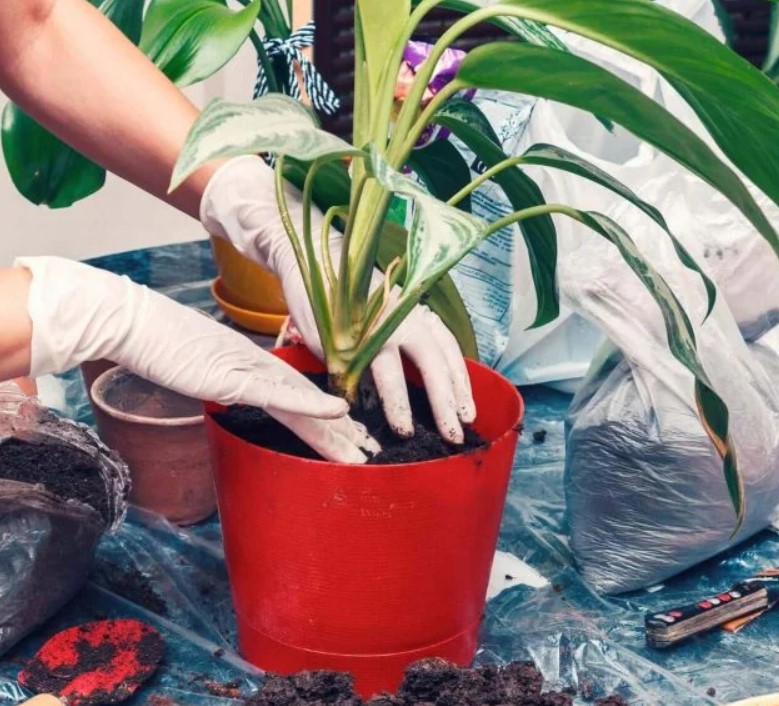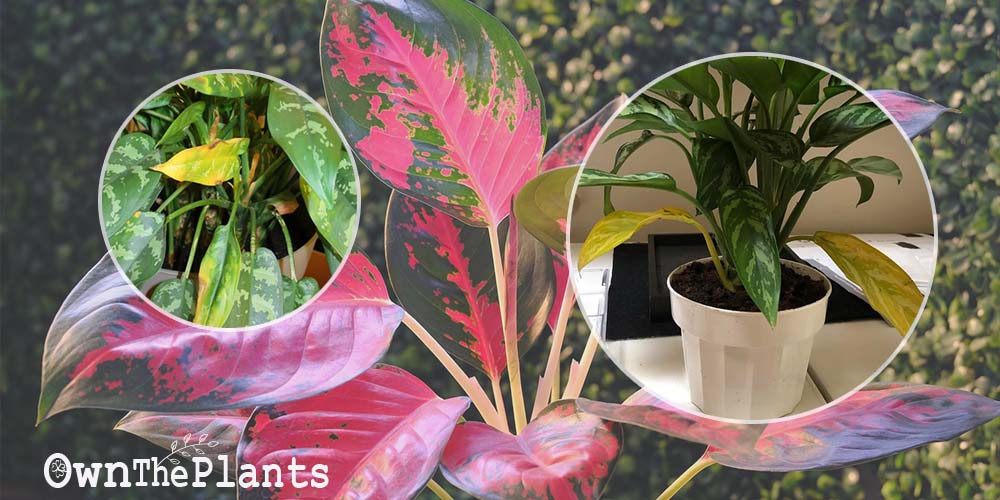To all Aglaonema lovers out there, we know how common it is to have one happy, flourishing plant the first day, just to have a yellowing, problematic plant the next. You might have find yourself wondering: What could I have done wrong?
Worry no more because we will help you get to the bottom of why your dashing plant leaves are yellowing, and of course, we will also show you how to fix it!
Sounds like a win-win situation, right?
Read this article to know more about avoiding having yellow leaves on your lovely Aglaonemas.
Why Are My Chinese Evergreens Having Yellow Leaves?
The occurrence of yellowing leaves in your Chinese Evergreens is a sign of imbalance in the environment they are in, or in the care that they are given.
Most commonly, incorrect watering, lack of moisture, improper lighting, and old age make your plant leaves yellow. Transplant stress also causes yellow foliage, as well as improper fertilization, and pests and diseases.
Depending on the pattern of yellowing, you can target on what causes problems to your plants and then rightfully and effectively fix them.

Watering Problems
Aglaonemas or your Chinese Evergreens thrive best when watered only when the top 1 to 2 inches of the soil is dry and cracky. Watering it whenever you feel like it and without proper routine will definitely cause you trouble.
If you suspect your plant is yellowing due to watering problems, it is most likely that it is due to having too much water rather than too little.
If you’re not sure of your culprit, below are the differences of having yellow leaves due to overwatering and underwatering.
Overwatering
Yellowing foliage of Chinese Evergreen is also a common symptom of overwatering.
The pattern of yellowing often starts on the lower leaves and then going up. If you observe this pattern, then most likely your plant’s problem is due to excess watering.
If you’re still unsure, you may look at these following symptoms that commonly go with excess watering to plants:
- Leaf edema or having small blisters filled with fluid on underside of leaves
- Droopy leaves despite moist soil
- Brown spots on leaves
- Rotting smell from soil (which is an indication of root rotting)
Even though Chinese Evergreens love their soil to be slightly moist at all times, a waterlogged condition is a no-no.
You may replace your pot with a smaller one with better drainage and holes. If the soil is not well-draining, replace it immediately.
Keep in mind that the time of watering your plants ultimately depends on the environmental conditions.
You will need to lessen watering during the winter season, or when temperatures or light conditions are low. Only water your plant when the top soil dries out.
Underwatering
An underwatered plant is much easier to diagnose and fix. The pattern of yellowing is the same as your overwatered plant, starting from the lower leaves and going up.
However, in this situation, yellowing foliage is always coupled with browning of tips and crispy leaf edges.
You will know that a plant is in need of water because it will look quite unhealthy and droopy. Plus, the soil around your plant will all be cracky and dry.
To fix this problem, observe your watering and make a habit of doing it regularly. If you observe that the soil dries very fast, check the environment.
You may need to change your plant’s location to somewhere with filtered light and an average temperature level.
Humidity Problems
Lack of humidity can also be the cause of yellowing leaves of your Chinese Evergreens. Especially in indoor locations, humidity levels can be very low, turning your leaves yellow to brown, or even die.
There are several ways to increase humidity levels to dry environment. You may mist your plant regularly during the day.
You may also group plants together or place them in a tray with pebbles and water to increase moisture level around them.
If these still fail to address your problem, try to shop for a modest humidifier to help you maintain the right humidity level for your plants.
Light Problems
The general rule for light conditions for plants is that purely green plants or green with white variegations will do good with lower light conditions or even artificial lighting.
But when more variegations and colors are present, the more light they need to healthily grow and flourish.
While Aglaonema plants tolerate low light conditions, they thrive best under indirect bright light.
In extremely low light, your variegated Aglaonemas will slowly lose their variegations. If the lighting remains poor, these leaves will turn yellow, starting from the lower leaves.

Consequently, in low light conditions, there is also a risk of having your plant overwatered because the water does not dissipate faster as that in high light environment.
To fix this problem, place your Aglaonema in a location with optimum light levels. When indoors, it can be beside a window with a sheer curtain.
Remember to avoid too much direct sunlight as it will burn the foliage and make your plant leaves curl.
Temperature Problems
Chinese Evergreens can be a little fussy with temperature changes. A sudden change in temperature or prolonged unfavorable temperature can definitely cause stress in your plants, which often results in yellowing of leaves, wilting, leaf damage, and even a growth halt.
When grown indoors, consider the drafts your plant may get from your appliances such as air conditioning and heaters, or even drafty windows.
Avoid placing your plants near these locations and position them away to avoid yellow leaves.
Your Chinese Evergreen plants thrive best in temperatures around 55°F to 80°F. Dropping below or going over this temperature range will elicit stress response to your plants.
Transplanting Problems

Although uprooting and replanting plants can be a very common garden chore, doing them actually stress the plants and should be done with proper care and right timing.
Plants get stressed out when they are abruptly replanted, just like your Chinese Evergreens.
Normally, Chinese Evergreens are very easy to repot as they easily adapt to new environment. However, if the transplanting is not done properly, your plants can develop yellow foliage and eventually wilt.
To avoid doing so, you make sure that the new pot is only slightly larger than the previous pot.
Use a well-draining soil mix. It is recommended to have a mix consisting of two parts garden soil, and one part perlite.
Fertilization Problems
Chinese Evergreens are not heavy feeders as they are slow growers, thus only small doses of fertilizers are enough for them to thrive. However, yellowing of leaves can also be due to fertilization problems.
Underfertilization
Especially if they have not been fed or repotted for years, yellowing of leaves is also a sign of nutrient deficiency.
Lack of nitrogen causes generalized yellowing and overall reduction of leaf color. Potassium and phosphorus deficiency, on the other hand, causes yellow and brown mottled discoloration on the leaves.
If you suspect nutrient deficiency is the problem, you must rectify your fertilizing schedule.
The plant should be able to revive and become healthy once given the right dose of nutrients. Do not expect for the damage foliage to fully recover.
Overfertilization
Although nutrient deficiency can be a cause of yellowing leaves, what’s more common is due to overfertilization.
However, this problem only occurs when the roots are already intoxicated by the excess salts due to excessive fertilizers.
Fertilizers have inorganic salt residues that are left in the soil. In advanced stages, leaf becomes yellow due to root toxicity.
To mitigate this problem, you should stop fertilizing during fall and winter. Your plants grow slowly over this time period, and thus more prone to overfeeding.
It is recommended that the feeding of plants only occur once or twice a year, during their growth season.
This is from spring to late summer. Your plants need a boost during this time because they are actively growing.
Pests Problems
All houseplants are in danger when it comes to pests, including your Chinese Evergreens.
If you observe sickly, mottled, yellow leaves or leaves with irregular holes in your plants, then you might have a pest problem.
Unfortunately, Chinese Evergreens are susceptible to tiny pests such as spider mites, mealy bugs, and aphids. Infestation to any of these small predators can be deadly to your Aglaonemas if left untreated.
These pests are easy to spot on your plants. Aphids are easy to find as they gather to feast on your plant juices.
Mealybugs tend to look like tiny cotton balls, usually on leaves or stems. Spider mites are the worst since they are hard to see. But if you see weblike structures in your plants, that’s a confirmatory sign that there is spider mite infestation.
The yellowing of leaves is due to the sucking of the plant’s fluids by these pests. Get rid of them at once using insecticides or horticultural oils, such as neem oils.
It requires a lot of patience and perseverance, but it will all be worth it!
Diseases Problems
Aside from pests problems, Chinese Evergreens are also susceptible to diseases, may it be viral or bacterial in origin.
The most common disease is Bacterial Blight, which is common to Aglaonemas around the world.
Yellowing of the leaves is a symptom of this Bacterial Blight. But the more obvious symptoms are large, spreading black spots on the leaf surfaces. Remember that this is almost exclusive to plants that are overwatered.
If this is the cause of your plant problem, immediately isolate the affected plant from the rest of your other plants.
Discard the affected leaves and dispose properly. Slowly nurse your plant back to good health by giving it proper care and attention.
Age
As the plant progresses, old leaves must die to pave for new, healthier ones. If your plants occasionally have yellowing leaves at the bottom, this is not a cause of alarm as this is normal.
Normally, you would have more yellowing leaves during the autumn and winter as the environmental conditions change.
With decreasing levels of light and temperature, the plant has to make its own sacrifices to maintain its general health.
Final Thoughts
The yellowing of leaves of your Chinese Evergreen can be due to many factors. Look over your plant and observe the environment it is in.
Water, light, moisture, temperature, and pests are common causes that merits investigation first.
More so, the unhealthy foliage can also be due to improper care and attention. Observe how you care for your plants – the time of your watering, feeding, and repotting. It could be that you must change your ways around them for the better.
No matter what the cause is, always remember that there is no plant that is perfectly healthy at all times.
An occasional yellowing of leaves is normal. Even the greatest horticulturists and plant scientists can’t have a perfectly healthy plant always.
We love to hear from you about your Aglaonema adventures in the comment section!
